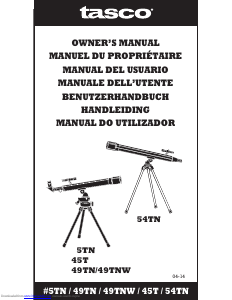Precise controls were built into your equatorial mount to hold the telescope steady. When view-
ing at high magnifications, even a slight breeze vibrating the body can impair your ability to see
detail. So to stack the cards on your side as much as possible against the limitations of nature, it
is important to balance your telescope (Fig. 15 and 16).
Level tripod by adjusting legs.
Loosen polar axis clamp and adjust polar axis to correspond to your observing latitude. If you
do not know your latitude, consult a map or atlas. Retighten clamp screw.
Loosen declination clamp screw and rotate telescope about the declination axis so that “90
on the declination scale is aligned with the fixed pointer. Retighten clamp screw.
Loosen hour axis clamp, rotate scope until the counter weight rod is in a horizontal position.
Do not tighten clamp screws.
If telescope is balanced, it will remain in place.
If telescope is out of balance, loosen counter weight thumb screw and slide weight along rod
until telescope remains in place. Tighten weight and hour axis screws.
The finderscope is a small low-powered and wide field of view telescope mounted alongside the
main telescope and is used to search for the target and aim the main telescope at it (I). Before
you can use the finderscope, youʼll need to line it up with the telescope. This is a simple proce-
dure once you know how and have practiced a little bit.
Install the lowest power eyepiece (20mm) into the eyepiece tube. Pick out an easily recognized,
unmoving object no closer than a thousand yards away. The higher the object is from the
horizon, the easier it will be to position the telescope. Aim your telescope toward your object
until its image is centered in the eyepiece. Lock all the knobs on the equatorial mount so the
Look through the finderscope. If the object you lined up in the telescope is not visible, loosen
the adjustment screws and move the finderscope around until you see it. Once it gets within
range, tighten the adjustment screws while centering the object in the scope. Youʼll note that
the image will shift toward the screw you are tightening (Fig. 8).
Adjust screws to center object on the finderscope cross hairs. Recheck your telescope to make
certain it is still on target. If it moved, realign it and adjust your finderscope. If it hasnʼt, youʼre
all set. Your finderscope is now operational.
The StarPointer is the quickest and easiest way to point your telescope exactly at a desired
object in the sky. Itʼs like having a laser pointer that you can shine directly into the night sky.
The star pointer is a zero magnification pointing tool that uses a coated glass window to super-
impose the image of a small red dot into the night sky. Like all finderscopes, the StarPointer
must be properly aligned with the main telescope before it can be used.
To turn on the StarPointer, rotate the variable brightness control clockwise until you hear a
“click.” To increase the brightness level of the red dot, continue rotating the control knob about
Locate a bright star or planet and center it in a low power eyepiece in the main telescope.
If the StarPointer is perfectly aligned, you will see the red LED dot overlap the alignment star. If
the StarPointer is not aligned, take notice of where the red dot is relative to the bright star.
Without moving the main telescope, turn the StarPointerʼs azimuth and altitude alignment con-
trols until the red dot is directly over the alignment star.
If the LED dot is brighter than the alignment star, it may make it difficult to see the star. Turn
the variable brightness control counterclockwise, until the red dot is the same brightness as the
alignment star. This will make it easier to get an accurate alignment. The StarPointer is now
ready to be used. Remember to always turn the power off after you have found an object. This
will extend the life of both the battery and the LED.
Look through the StarPointer finderscope and pan the telescope until the object appears in the
field of view. Once itʼs in the field, tighten the altitude and azimuth locks.
To center the object with the red dot in the StarPointer, use the fine adjustment ring on the alti-
tude slow motion rod assembly.











Praat mee over dit product
Laat hier weten wat jij vindt van de Tasco 40-060675 Galaxsee Telescoop. Als je een vraag hebt, lees dan eerst zorgvuldig de handleiding door. Een handleiding aanvragen kan via ons contactformulier.
beantwoord | Ik vind dit nuttig (0) (Vertaald door Google)